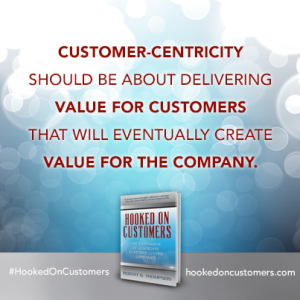A Review Of Bob Thompson’s “Hooked On Customers”
 Over the past year, we have had the fantastic opportunity to contribute articles to CustomerThink.com, and have found the site to be an amazing compilation of all resources necessary to transform our companies into customer-centric organizations. Armed with a wealth of knowledge and experience, CEO and editor-in-chief Bob Thompson has written Hooked On Customers: The Five Habits of Legendary Customer-Centric Companies.
Over the past year, we have had the fantastic opportunity to contribute articles to CustomerThink.com, and have found the site to be an amazing compilation of all resources necessary to transform our companies into customer-centric organizations. Armed with a wealth of knowledge and experience, CEO and editor-in-chief Bob Thompson has written Hooked On Customers: The Five Habits of Legendary Customer-Centric Companies.
In the book, Thompson shares his five tried and true habits as a system that companies must employ in order to become customer-centric. The five habits are:
- Listen
- Think
- Empower
- Create
- Delight
Thompson not only gives practical advice on how to improve in each of these five areas, but he also gives case studies from companies that do each of these well. He further supports them with research to show that by adopting these habits, our businesses will see positive results.
Rather than continuing with a comprehensive overview of the book, I want to take a few moments to share four things that I found most useful in my journey toward being customer-centric.
A History Lesson
As someone entrenched in the world of customer service, I found Thompson’s history lesson of customer relationship management (CRM) and customer experience management (CEM) to be particularly useful. While CRM enables businesses to use technology and processes to manage customer relationships, its tendency to treat customers like leads, deals, or incidents fails to capture the humanity of the individual and fails to drive customer loyalty.
CEM on the other hand focuses more on the individual customer, aiming at understanding their unique needs, feelings and perceptions. Thompson says, “Instead of just looking at how valuable the customer is to the enterprise, CEM requires an inspection of the enterprise’s value to the customer.” He gives us an image of CEM and CRM as a yin-yang and says that in order to be truly customer-centric, we need both to be working in balance.
Thinking With Big Data
Big data is a big term being spoken and written about often in recent years. Thompson helps to make practical sense of this for customer-centric organizations. He gives a specific example of JetBlue, who uses text mining to gauge the sentiment from customer emails, and then ties the feedback to the particular aircraft and even seat the customer sat in. This allows the airline to more accurately fix problems as they arise.
Another way to find out what customers are saying and analyze it more effectively is through speech analytics. Thompson gives the example of Blue Cross of Northeastern Pennsylvania, who began mining their audio recordings from phone calls to find common reasons customers were calling. They used this data to fix common problems. Call volume was subsequently reduced and the customer experience improved.
AIM
Thompson points out that customer-centric companies empower their employees to make decisions that will better serve their customers. He gives us AIM, which is a simple formula for empowering our customer service representatives. AIM stands for Authority, Insights and Motivation.
We first must give employees the authority to make decisions in order to recover service for the customer. The word, “lagniappe,” means giving a little something extra — a terrific concept to remember. Empower your customer service staff with that little something extra they can give to customers when resolving problems.
Representatives must then have the insight necessary to resolve issues on the first contact. The more agents are empowered with the proper knowledge and training, the better the customer experience.
Finally, employees must be motivated to delight customers. It is essential that we determine the outcomes we desire and reward and motivate employees to achieve those outcomes. Our entire rewards systems must be centered around delighting customers.
Courage To Fail
A final concept that I found most useful was the idea that failure is an essential part of creation. Thompson says:
Most companies focus on fixing problems and refining what they’re already doing. That’s all well and good, but customer-centric leaders also strive to create new products and services for unmet customer needs.
He goes on to give an example where the company Intuit had their Quicken Health Expense Tracker, which was filling a need in helping families track their medical expenses. In 2012, the company shut this down after recognizing a much greater need among customers. Rather than allowing their competition to make this software irrelevant, they innovated their Health Patient Portal, which ended up being the right decision. Thompson makes this terrific point:
How many companies are littered with products on life support because leaders don’t have the guts to stop and move on to better solutions?
When companies are truly customer-centric, they are seeking to create solutions to meet customer needs. These needs may change and it is critical that we have the courage to change and even try new things that may fail.
Hooked On Customers is an invaluable resource to any company looking to become more customer-centric. If you commit to reading and implementing these five habits in your organizations, your customers will thank you for it and your business will flourish. If you have read the book, please take a moment to share some of your favorite insights with us.
[custom_author=admin]
Nice review Jeremy. I still don’t know when you find time to sleep.